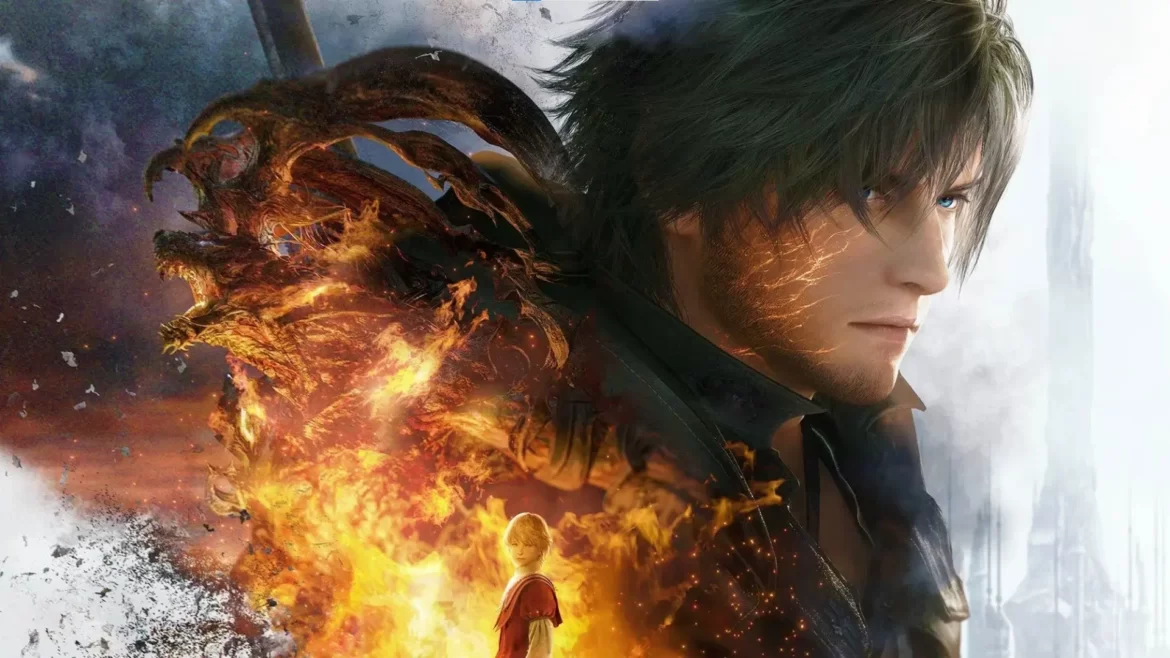Release Date : June 22, 2023
Developer(s) : Square Enix Creative Business Unit 3
Publisher(s) : Square Enix
Platforms : PS5
First announced in 2020, Final Fantasy XVI is a highly anticipated episode. Following the troubled launch of Final Fantasy XV, this new opus continues the action turn initiated by its predecessor by going even further. But at the same time, it offers a kind of return to its roots with a medieval universe, but in a darker, more mature atmosphere. After the success of Final Fantasy VII Remake, does Final Fantasy XVI have what it takes to ensure the saga’s resurrection in the eyes of the general public?
Before getting started with this review of Final Fantasy XVI, it’s important to know about the team behind it. Development is handled by Square Enix Creative Business Unit 3 (CBU3), which is responsible for MMORPGs such as Final Fantasy XI Online and, above all, Final Fantasy XIV. The unit is led by Naoki Yoshida, producer and director of FFXIV, who “rescued” the title after its catastrophic initial launch in 2010, bringing it back to life in 2013 with a 2.0 version named A Realm Reborn. With a decade of expansion releases, Final Fantasy XIV has become the franchise’s most profitable episode, and one of its most popular among fans. With this success in hand, Square Enix’s management decided to entrust this division with the task of developing the next episode in the saga, the famous Final Fantasy XVI.
On this project, Naoki Yoshida is “only” producer, while Hiroshi Takai, his right-hand man during the redesign of FFXIV, takes on the role of director. For the script, we have Kazutoyo Maehiro, who also worked on FF14, but above all on Final Fantasy Tactics and Final Fantasy XII, as well as art director Hiroshi Minagawa. While these key figures come from FF14, Ryota Suzuki, the combat director, is a Capcom veteran. In the past, he worked on Devil May Cry 5, whose influence is obvious here. With this “Dream Team”, does Final Fantasy XVI live up to its promise to be more action-oriented than ever? Here’s our spoiler-free answer.
Table of Contents
A Story and Universe Both Fascinating and Mature

Final Fantasy XVI is set in the medieval world of Valisthea, plagued by the Black Scourge, an evil that drains the land of its magical essence, making it unsuitable for living. With their resources running low, the continent’s various nations wage a war for survival. Most of them have a MotherCrystal, a huge crystal structure from which fragments are extracted to make magic, and an Emissary, a character who possesses the power of Eikon, which is the name given to the summons in this episode, and is capable of transforming into one of the powerful creatures.
The story follows the adventures of Clive Rosfield, son of the Archduke of Rosaria and Guardian of the Phoenix, in other words, the nation’s Eikon, with Joshua, his own younger brother, as the Emissary. As the nation prepares to go to war to reclaim its lands, Rosaria’s army is massacred in a surprise attack, killing the Archduke and Joshua, leaving Clive as the only survivor. Now reduced to a slave in the service of the Empire, he vows revenge on the mysterious hooded man and the second Eikon of Fire who killed his little brother.
The storyline and universe of Final Fantasy XVI are exciting, for several reasons. First and foremost, the writing is top-notch, and the dialogue is excellent, making the characters engaging, with credible relationships and tangible motivations. In a way, FFXVI reconnects with the origins of the franchise by placing a reflection on humanity at the heart of its plot, with nods to previous installments. At the core of this plot, the world of Valisthea is so well developed that it becomes a character in its own right, fascinating with the number of details the developers have come to imagine.

Slavery and freedom are central concepts in this episode, explored both in the story and in the side quests. With its great writing style, Final Fantasy XVI manages to keep players on the edge of their seats for the 35 to 40 hours of its main story. In the end, its only drawback is that the beginning is rather slow, with numerous cutscenes and little gameplay, which may discourage some players, but is necessary to lay the foundations for the adventure.
With its dark, mature aspects, Game of Thrones’ influence is definitely present, as the developers themselves confessed in an interview. Injury, nudity, bloody violence, slavery… We find all the elements that have made Westeros both cruel and realistic. While the HBO series is an obvious influence, we shouldn’t forget that previous games in the franchise already offered this kind of universe. Long before GoT, FFXII and especially FF Tactics were already using this approach. So, as in those two games, it’s no surprise that geopolitics plays a central role in the plot of FF16, while still being staged in a theatrical fashion. And since the game is full of references that can confuse the player, the developers have thought of everything.
During the cutscenes, the Chronography feature lets you pause to access cards that summarize the elements mentioned on screen. Later on, The Hideaway allows us to consult Viviane’s Chronicles, which provide access to maps to help us understand what’s going on in Valisthea. These are more than useful options, especially in a saga where some episodes have been criticized for their confusing storylines due to poorly explained or unexplained concepts.
Action, Fantasy, and Eikons
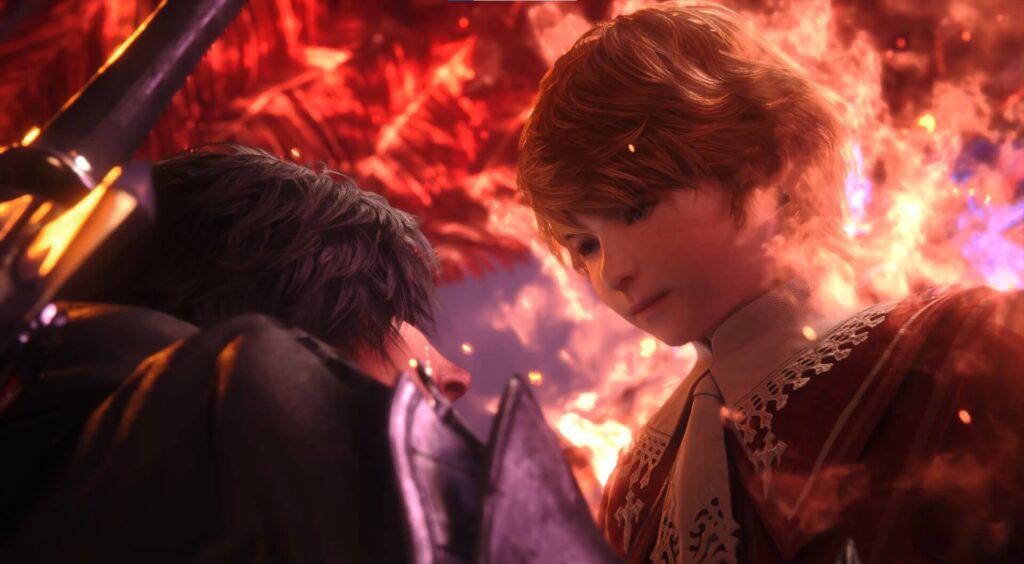
While Final Fantasy is famous for its role-play combat, Final Fantasy XVI is even more about action than its predecessor. This time, the focus is clearly on the beat’em up experience, featuring intense battles. As we saw earlier, Ryota Suzuki, one of the game designers from Devil May Cry 5, is the director of combat, and this is reflected in the gameplay. In Final Fantasy XVI, the player controls Clive exclusively throughout the adventure.
With the joystick in hand, there’s a button for sword strikes and basic combos, a button for casting small spells from a distance, and a jump and dodge button. By dodging a hit at the right moment, a counter can be triggered with a stylish animation. Thanks to the skill tree, new abilities can be unlocked, such as charging a blow or allowing Clive to dash towards an enemy, blade forward. Above all, Clive is often accompanied by his dog Torgal, who can be given commands to continue a combo, throw an enemy into the air, or heal himself. While Final Fantasy XVI’s basic gameplay is simple but effective, especially with Clive’s stylish animations, it’s with the Eikon powers that it becomes truly exhilarating.
Throughout the adventure, Clive can acquire Eikon abilities to help him on his quest. With the controller in hand, this translates into a special skill that the player can use whenever he wants (teleportation for Phoenix, grappling hook for Garuda, guard for Titan…), as well as two abilities with a cooldown time. These abilities feature impressive, high-impact animations, making them both efficient and spectacular. In the skill tree, each Eikon offers four different skills, including an ultimate one with a much longer cooldown time than the others. So you’re bound to make a choice, because in combat, only two skills can be chosen for each Eikon.

With all these elements in hand, there’s plenty of scope for spectacular combos, especially as Clive can “equip” himself with three sets of Eikons at the same time, and switch from one to the other at the touch of a button. Once you’ve spent enough points in the skill tree, you can even place a skill in any of the sets, allowing you to create your ideal setup at the end of the game.
However, Final Fantasy XVI’s combat system doesn’t rely solely on mindless strikes to defeat your enemies. For certain foes, we find the Shock/Stagger mechanic first introduced in Final Fantasy XIII and carried over into Final Fantasy VII Remake, but in an alternative form. Below the life gauge of bosses and other stubborn opponents, there’s a gauge that shrinks with each blow. Once empty, the enemy becomes destabilized, meaning he’s knocked down, and the player can do much more damage to his target.
With this in mind, certain Eikon skills can be used to lower this gauge more effectively, instead of dealing more damage. And believe me, you’re going to be using this mechanic a lot, because certain monsters are real HP bags, especially in New Game+. If you’re afraid of getting lost in all this because you’re not used to action games, don’t worry, we’ve got you covered. To make the game more accessible, the developers have created five accessories that facilitate certain aspects of the experience. You can perform combos by pressing the same key, slowing down the action to avoid an attack, or automating Torgal’s attacks, potion consumption or dodges… Up to three accessories can be equipped so that everyone can enjoy combat as they see fit.
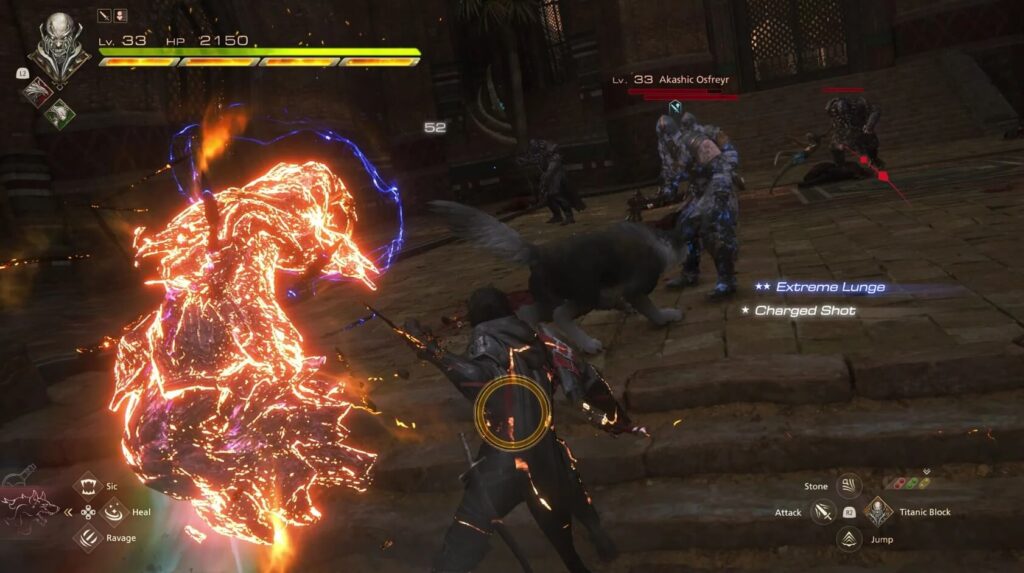
While we control Clive most of the time, Final Fantasy XVI also lets us embody some Eikon creatures on several occasions. Each battle is unique and offers a different approach, ranging from Clive-like gameplay to a Shoot ‘Em Up experience. While these battles are fun to play, it must be said that they sometimes take too long. In fact, it’s the visuals that make these confrontations so impressive. The developers have made sure that these moments benefit from the most epic staging possible, not hesitating to draw inspiration from Anime. Dragon Ball, Naruto, Attack of the Titans, and above all, Neon Genesis Evangelion, all these references help us feel the power of the Eikons.
The influence of other video games, such as the first God of War trilogy and, above all, the Bayonetta series (with a direct reference), can even be felt in the intense battles. Generally speaking, all the boss battles are impressive, and rest assured, they don’t feature that many QTEs. In any case, one thing’s for sure: Final Fantasy has never offered such epic confrontations in its history, especially in its truly spectacular ending.
Between Linearity and Open-Zones, an Outdated Structure
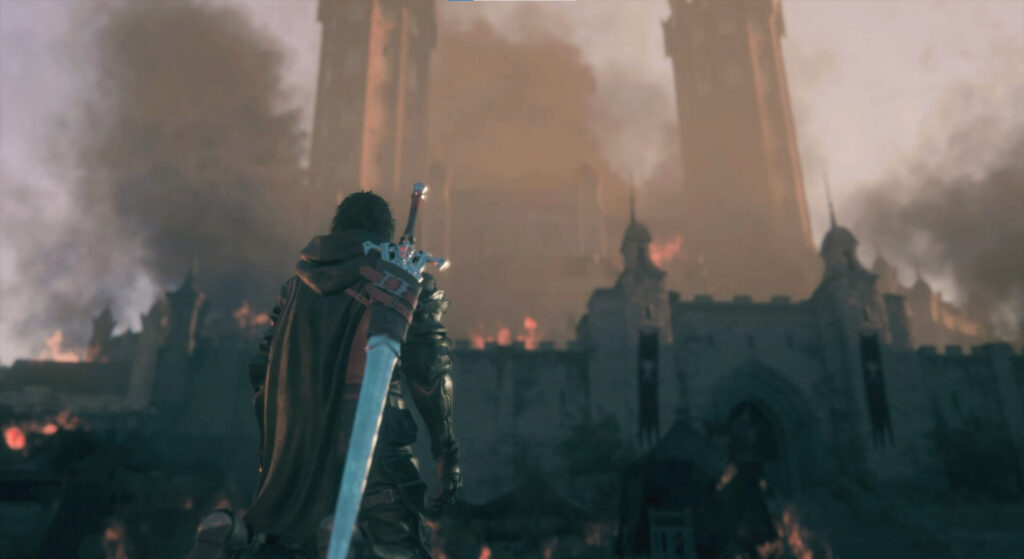
For a long time, the structure of Final Fantasy XVI raised questions among many gamers. Early on, Naoki Yoshida stated that Final Fantasy XVI would not be an open-world game, but an adventure similar to God of War (2018) in terms of progression. But what does this mean in concrete terms? Well, you could say that the experience is divided into two distinct parts. On one hand, there are dungeons of sorts, which are linear levels that feature one battle after another, and from which you can barely stray from the main path to collect items. These are moments that serve above all to advance the plot, and their structure is quite reminiscent of Final Fantasy XIV’s dungeons, as you progress from one arena to the other.
In addition to these successive battles, the story takes us through open levels, with plains full of monsters and living villages. While these areas may seem small and linear initially, we eventually discover that all sections of the same region form a single unit, resulting in large play areas. Between these two types of levels, you spend most of your time at The Hideaway, which serves as a hub from which you can purchase items and equipment, and also access the world map to find your way to a region or dungeon.
Final Fantasy XVI’s biggest weakness lies in its structure. Although the game alternates between dungeons and more open levels, the overall experience is rather linear and directional. We’re usually happy to move from one arena to the next until we reach a boss, or from one village to the other to complete simple tasks that unlock the next dungeon. This feeling of repetition is made even more pronounced by the fact that exploration is rarely rewarding, regardless of the type of level chosen. Straying from the main path only allows you to pick up items that are often dispensable, whether potions or crafting materials.

Moreover, equipment doesn’t play a major role in the game, which means there’s even less reason to wander around Valisthea, unless it’s for side quests or hunting. Fortunately, you don’t feel caught up in the rhythm like in Final Fantasy XIII, but instead, you’re carried along, like in Final Fantasy X. This is due to an excellent storyline and ten or so hours of cutscenes that keep the player hooked. In addition, throughout the adventure, we alternate between major moments that advance the plot, and others that are less captivating but important for the rest of the story. Unfortunately, it’s in these more secondary moments that the cutscenes use simple animations and a much flatter, field vs. field staging, reminiscent of Final Fantasy XIV. This dated structure and staging create a real mismatch with the modern feeling of the experience, which regularly detracts from the immersion.
Regarding the additional content, it’s important to note that it’s often interesting from the point of view of the universe. Much like The Witcher 3, some of the side quests are well-written and explore in depth the many themes that run through Valisthea, even in the most routine tasks. If you’re interested in this universe, we highly recommend doing them for all they add to the lore. On the other hand, they are rarely exciting. Most of the time, you’re just talking to someone, killing monsters, or bringing back an item, which means that side quests are rarely exciting from a gameplay point of view.
To conclude on the subject of additional content, we should point out that the title also offers a hunting board to challenge powerful creatures, rather like Final Fantasy XII. This extends the game’s lifespan by a further ten hours or so. And for those who want more, remember that the game includes a New Game+ with higher difficulty, much tougher enemies, and the possibility of crafting new weapons. A good opportunity to test the skills unlocked at the end of the game, which we weren’t able to take advantage of. Beyond its content, Final Fantasy XVI is designed to be replayed, to keep players on their toes, through challenges and higher difficulty modes.
A note on the music
The soundtrack features Masayoshi Soken, known for his work on Final Fantasy XIV. Here, he provides excellent ambient tracks during exploration, epic themes during boss battles, and even some of the offbeat elements for which he is renowned. Despite the qualities of this original soundtrack, it remains a little less inspired than FFXIV’s productions.
A True Next-Gen Experience, but With Some Shortcomings

To complete this review of Final Fantasy XVI, it’s time to talk about the graphics. Visually, this episode is a success. Throughout the adventure, Valisthea is a delightful fantasy world offering magnificent panoramas, particularly thanks to the massive MotherCrystals. These landscapes bear witness to the artistic team’s work on the environments and architecture to lend a unique charm to this universe.
This beauty can also be observed in the cutscenes of the main plot, which are particularly well-designed, resulting in realistic facial animations for the characters. And, as we mentioned earlier, it’s the Eikons and boss battles that are truly impressive, both in terms of staging and visual effects. Since the title is a PS5 exclusive, it takes full advantage of the console’s hardware, such as the SSD, which makes it possible to travel from one end of Valisthea to the other in a matter of seconds, which is a very pleasant feature.
However, Final Fantasy XVI is not a completely flawless technical experience. In the dungeons, there are numerous narrow passages and doors to push through, with QTEs that are actually loading times in disguise. Then there’s the frame rate, in performance mode, Final Fantasy XVI battles are mostly fluid, often running at 60 FPS, with occasional delays during boss battles with the most effects. Meanwhile, The cutscenes run at 30 FPS, even in performance, but this isn’t too distracting.
On the other hand, when exploring certain villages and between battles, the framerate tends to go up and down in performance mode. Admittedly, the game never gets to the point of crawling and dropping below 30 FPS, but these ups and downs are frequent enough to be obvious to the naked eye. Aware of the problems, the developers have announced that a Day One patch will be deployed to correct this issue, but we haven’t had a chance to try it out yet.
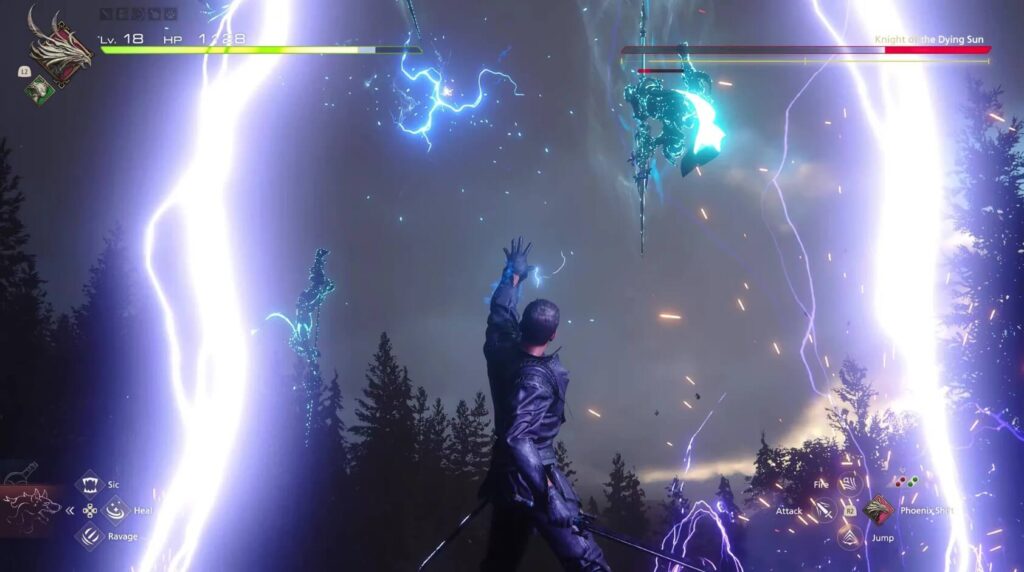
Conclusion
Final Fantasy XVI is a stunning visual experience that goes straight to the heart of its purpose, what it wants to achieve, and how it wants to represent the saga. The result is an episode that, at times, is straightforward, with few detours and a desire to maintain a certain simplicity in its approach in order to appeal to an audience not usually interested in RPGs. This has its charm (as well as its limitations), so much so that we quickly become attached to this very special episode, which is full of love for the franchise. It’s a completely different experience, both imperfect and convincing, which could undoubtedly have gone further, just as easily as it could have failed. It’s a great feat itself, a special episode among the other episodes, and takes the series in a new direction with style. The Final Fantasy that the series just needed.
